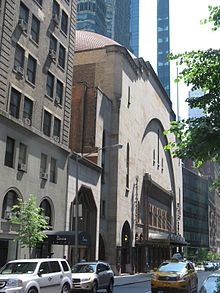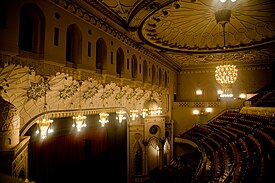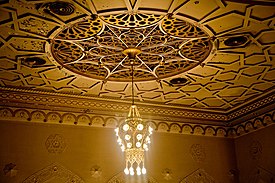New York City Center
 New York City Center in 2010 | |
 | |
| Address | 131 W. 55th St. New York, New York United States |
|---|---|
| Owner | City of New York |
| Operator | City Center 55th Street Theater Foundation |
| Type | Performing arts center Off-Broadway (MTC) |
| Capacity | Main stage: 2,257 Stage I: 300 Stage II: 150 |
| Construction | |
| Opened | 1922 (Main stage) 1984 (Stages I & II) |
| Architect | Harry P. Knowles and Clinton & Russell |
| Website | |
| www | |
Mecca Temple | |
U.S. National Register of Historic Places | |
NYC Landmark
| |
 | |
| Coordinates | 40°45′50″N 73°58′48″W / 40.76389°N 73.98000°WCoordinates: 40°45′50″N 73°58′48″W / 40.76389°N 73.98000°W |
| Area | less than one acre |
| Architectural style | Moorish |
| NRHP reference No. | 84002788[1] |
| Significant dates | |
| Added to NRHP | September 7, 1984 |
| Designated NYCL | April 12, 1983 |
New York City Center (previously known as the Mecca Temple, City Center of Music and Drama,[2] and the New York City Center 55th Street Theater[3]) is a 2,257-seat Moorish Revival theater at 131 West 55th Street between Sixth and Seventh Avenues in Midtown Manhattan, New York City, one block south of Carnegie Hall. City Center is a performing home for several major dance companies as well as the Encores! musical theater series and the Fall for Dance Festival. The facility houses the 2,257 seat main stage, two smaller theaters, four studios and a 12-story office tower.[4]
Architecture[]
The building's design is Neo-Moorish and features elaborate interior and exterior polychromed tile work, murals, and a recently restored terra cotta tiled rooftop dome. The 102-foot (31 m) wide, 54-foot (16 m) tall dome is covered with more than 28,000 individual tiles. The building was designed by architects Harry P. Knowles (a Master Mason), who died before its completion, and Clinton & Russell. The auditorium and three Masonic lodge rooms included four M.P. Moller pipe organs.
History[]
The New York City Center was designed by architect Harry P. Knowles and the firm of Clinton & Russell and built in 1923.[3] It was originally called the Mecca Temple, by the Ancient Arabic Order of the Nobles of the Mystic Shrine, more commonly known as Shriners. The group had previously held their meetings at Carnegie Hall. According to Broadway lore, Carnegie Hall management was disturbed by the amount of cigar smoke generated during Shriners meetings and evicted them.[citation needed] Although the Shriners owned a clubhouse at 107 West 45th Street, large meetings had earlier been held in Carnegie Hall and in the concert hall of Madison Square Garden.[5]
Construction[]

In 1921, Mecca Temple bought the Famous Players-Lasky Corporation movie studio site from Yale University for $400,000.[6] The cornerstone (visible today on West 56th Street) was laid on December 13, 1923 by Judge Arthur S. Tompkins,[7] Grand Master of Masons in New York State. The dedication ceremony took place onstage, December 29, 1924, with the invocation offered by Episcopal Bishop William T. Manning.[8] The first public musical concert took place late the next year, by John Philip Sousa's (a Mason) band, with Walter Damrosch and Willem Mengelberg among the audience.[9]
1940s to 1960s[]
After the financial crash of 1929 the Mecca Shriners were unable to pay the taxes on the building and it became city property. By the early 1940s, the building was slated for demolition when New York City Council President Newbold Morris and Mayor Fiorello La Guardia decided to convert the building into a home for the performing arts. On December 11, 1943, with publicist and future producer Jean Dalrymple in charge as the volunteer director of public relations, the New York City Center of Music and Drama opened its doors with a concert by the New York Philharmonic. "The Star-Spangled Banner" was conducted that evening by Mayor La Guardia.
Each season, from the 1940s through the 1960s, City Center presented numerous music and theatrical events with many renowned performers appearing there. Helen Hayes, Montgomery Clift, Orson Welles, Gwen Verdon, Charlton Heston, Marcel Marceau, Bob Fosse, Nicholas Magallanes, Francisco Moncion, Tallulah Bankhead, Vincent Price, Jessica Tandy, Hume Cronyn, Uta Hagen, and Christopher Walken have all graced the City Center stage. The center was also famous as an inexpensive venue for revivals of dozens of classic and then-recent Broadway musicals, among them Oklahoma!, Carousel, South Pacific, and Show Boat.
One of the first dance companies to perform regularly there was the Ballet Russe de Monte Carlo, from 1944 to 1948. New York City Center was home to the New York City Opera (1944–1964)[10] and the New York City Ballet (1948–1966). City Center's office tower was home for the production team who created the famed television show "Your Show of Shows" starring Sid Caesar. With the 1960s construction of Lincoln Center for the Performing Arts, City Center Theater lost New York City Opera and New York City Ballet, and once again faced demolition. After Newbold Morris retired, Morton Baum, Chairman of the Finance Committee of the Board led City Center. With the assistance of Lincoln Center, NYCB and NYCO were organized into membership corporations with "City Center of Music and Drama" as the sole member. "CCMD" leased the New York State Theater from Lincoln Center, which leased it from the City of New York.


In 1966, the Robert Joffrey Ballet became a resident dance company, even changing its company name to "City Center Joffrey Ballet." The Joffrey remained at City Center until 1992. "In its brief heyday, the Joffrey danced two six-week seasons at City Center each year."[11]
1970s to 1990s[]
Since the departure of the opera and ballet companies from the 55th Street building, the corporate name City Center of Music and Drama has referred to the umbrella organization for those Lincoln Center companies. After the shift, the City Center theater on 55th was reorganized as the City Center 55th Street Theater Foundation, under Howard M. Squadron, and the building given landmark status.
In celebration of the Metropolitan Museum of Art Centennial, the City Center co-sponsored “Cinémathèque at the Metropolitan Museum,” which showed seventy films dating from the medium's first seventy-five years on thirty-five consecutive evenings from July 29 to September 3, 1970. The films were selected by Cinémathèque Française founder and director Henri Langlois, from its archive of more than 50,000 films. Chosen for their significance and contributions to the history of filmmaking, they included work from official film industries as well as current and early avant garde directors. The program was the most diverse film exhibition held in the United States to date.[12]
In 1984, Manhattan Theatre Club made New York City Center's lower level (originally a 136'x96' banquet hall) its home. Manhattan Theatre Club performance space comprises a 299-seat theater and a 150-seat theater. Later in the 1980s, the main stage was extensively renovated in connection with the adjacent construction of the high-rise mixed-use building, Cityspire: "To complete the deal, Eichner Properties agreed to contribute $3 million to the City Opera and $3 million to the City Ballet, which covered the purchase of the air rights ... and to spend $5.5 million to renovate the theater in exchange for the 20 percent space bonus."[13] The renovations were designed by the architect .[3]
In 1994, New York City Center launched its first Encores! Great American Musicals in Concert productions. The popular series, which continues to this day, spawned the Broadway revivals of Chicago, Wonderful Town, The Apple Tree, Gypsy (2008), and Finian's Rainbow. Those Broadway productions were produced independently of City Center, but with many of the artists and creators of the Encores! performances.
2000s to present[]
In 2000, the American Theatre Wing presented a Tony Honors for Excellence in Theatre award to City Center for the Encores! series.
In 2004, New York City Center introduced the annual Fall for Dance Festival, which has received international acclaim for its quality, innovation and success in introducing new and younger audiences to the world of dance. Since its inception, the Festival has presented 165 different dance companies to almost 200,000 people. Newcomers and dance enthusiasts alike look forward to Fall for Dance as both an introduction to new artists and a welcome return to familiar and beloved companies.
In 2010, City Center started a $75 million project to renovate its landmark building. The design was managed by Ennead Architects LLP (formerly Polshek Partnership Architects) and included improved sightlines, improved seating and a new canopy, as well as restoration of historical elements like mosaic walls, arabesque ceilings and the original box-office lobby. The construction work occurred from April to September, 2010 and from mid-March to October 2011 completion.[4] The building was reopened in October, in a ceremony led by New York City Mayor Michael Bloomberg.[14]
Several new programs were introduced in the 2011-12 season, including the New York City Center Choreography Fellowship, a program that supports choreographers at critical stages of their careers. The program continues City Center's long history of nurturing choreographers, from George Balanchine to Christopher Wheeldon. That season also saw the launch of a new producing partnership between City Center and Jazz at Lincoln Center. Its inaugural production, Cotton Club Parade, opened on Broadway in the fall of 2013 with the new title After Midnight.
New York City Center's newest offering, Encores! Off-Center, launched in the summer of 2013. Composer Jeanine Tesori (Fun Home, Violet) is the artistic director of this new series, which features seminal Off-Broadway musicals filtered through the lens of today's most innovative artists. The inaugural season included Marc Blitzstein’s The Cradle Will Rock, Gretchen Cryer and Nancy Ford's I’m Getting My Act Together and Taking It on the Road, and Jeanine Tesori and Brian Crawley's Violet, which will make its Broadway debut in the spring of 2014.
Today, New York City Center is the New York performance home to Alvin Ailey American Dance Theater, Manhattan Theatre Club, The Flamenco Festival, and the Martha Graham Dance Company, to name a few.
See also[]
- List of New York City Designated Landmarks in Manhattan from 14th to 59th Streets
- National Register of Historic Places listings in Manhattan from 14th to 59th Streets
References[]
- ^ "National Register Information System". National Register of Historic Places. National Park Service. March 13, 2009.
- ^ Jackson, Kenneth T., ed. (2010). The Encyclopedia of New York City (2nd ed.). New Haven: Yale University Press. pp. 228. ISBN 978-0-300-11465-2.. The name "City Center for Music and Drama Inc." is the organizational parent of the New York City Ballet and, until 2011, the New York City Opera.
- ^ Jump up to: a b c White, Norval & Willensky, Elliot (2000). AIA Guide to New York City (4th ed.). New York: Three Rivers Press. p. 267. ISBN 978-0-8129-3107-5.
- ^ Jump up to: a b New York Times, March 17, 2010, pg C1, "City Center Is to Start Renovations", by Robin Pogrebin
- ^ "Shriners Plan Own Home", The New York Times, June 15, 1911
- ^ *"Shriners Here Plan $2,000,000 Mosque", The New York Times, December 15, 1921
- ^ *"Shriners at Site of New Mosque", The New York Times, December 14, 1923
- ^ *"Shriners Dedicate Mecca's New Home", The New York Times, December 30, 1924
- ^ *"Sousa Opens New Mecca Temple Hall", The New York Times, October 12, 1925
- ^ "New York City Opera: Handsome young troupe brightens U.S. music scene" in Life, April 11, 1949: pp. 118-122.
- ^ Barnes, Clive (May 1996). "A phoenix called Joffrey". Dance Magazine. Retrieved 2006-10-25.
- ^ Finding aid for the George Trescher records related to The Metropolitan Museum of Art Centennial, 1949, 1960-1971 (bulk 1967-1970) Archived 2019-04-12 at the Wayback Machine. The Metropolitan Museum of Art. Retrieved 8 August 2014.
- ^ *The New York Times, February 21, 1986 (Scardino, Albert)
- ^ "Transitions". Preservation. National Trust for Historic Preservation. 64 (1): 6. 2012.
Bibliography[]
- Botto, Louis. Playbill: At This Theatre (Applause Books, 2002) (ISBN 1-55783-566-7)
- Dalrymple, Jean. From the Last Row (James T. White & Company, 1975)
- Doeser, Linda. Ballet and Dance: The World's Major Companies (St. Martin's Press, 1977) (ISBN 0-312-06599-X)
- Kirstein, Lincoln. Thirty Years: The New York City Ballet (Knopf, 1978) (ISBN 0-394-50257-4)
- Moore, William D. Masonic Temples: Freemasonry, Ritual Architecture, and Masculine Archetypes. (University of Tennessee Press, 2006) (ISBN 1572334967)
- The New York Times, November 17, 1998.
- The New York Times, October 7, 1990 (Dunlap, David W.).
- The New York Times, December 17, 1995 (Lambert, Bruce).
- The New York Times, August 13, 1997 (Dunlap, David W.).
- The New York Times, April 11, 1999 (Gray, Christopher).
- The American Architect, February 25, 1925. (periodical)
External links[]
| Wikimedia Commons has media related to New York City Center. |
- Official website
- City Center at the Internet Broadway Database
- New York City Center-Stage I at the Internet Off-Broadway Database
- New York City Center-Stage II at the Internet Off-Broadway Database
- Alliance for the Arts web listing
- Clubhouses on the National Register of Historic Places in Manhattan
- Concert halls in New York City
- Culture of Manhattan
- Dance venues in the United States
- Former Masonic buildings in New York (state)
- Masonic buildings completed in 1923
- Midtown Manhattan
- Moorish Revival architecture in New York City
- New York City Designated Landmarks in Manhattan
- Shriners
- Special Tony Award recipients
- Theatres in Manhattan
- Theatres on the National Register of Historic Places in Manhattan


